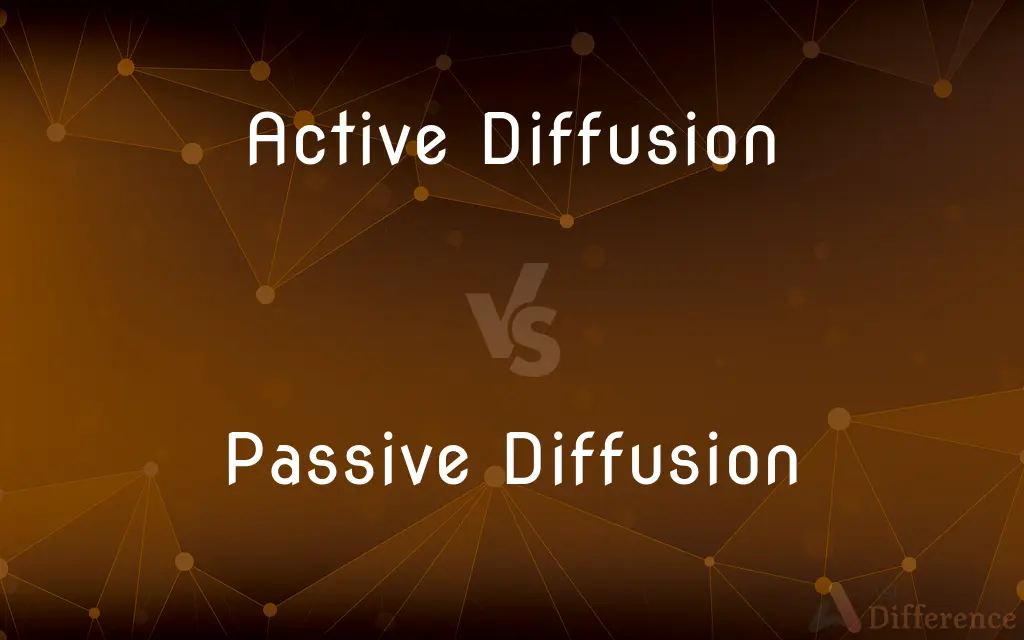Active Diffusion vs. Passive Diffusion — What's the Difference?
Edited by Tayyaba Rehman — By Fiza Rafique — Published on December 17, 2023
Active Diffusion requires energy to move substances against a concentration gradient. Passive Diffusion allows substances to move naturally down their concentration gradient without energy.

Difference Between Active Diffusion and Passive Diffusion
Table of Contents
ADVERTISEMENT
Key Differences
Active Diffusion and Passive Diffusion are fundamental processes regulating the movement of molecules within biological systems. While Active Diffusion relies on the use of energy, often from ATP, to move substances against their concentration gradient, Passive Diffusion operates without any external energy source, letting molecules flow freely from a region of high concentration to one of lower concentration.
The process of Active Diffusion is facilitated by specific transport proteins, which help pump substances across cellular membranes. These transport proteins are critical in maintaining cell homeostasis. In contrast, Passive Diffusion does not necessarily involve any transport proteins, as molecules can move directly through the lipid bilayer, depending on their solubility and size.
Active Diffusion is a selective process, as only certain molecules are transported based on the availability of the appropriate transport proteins. This selectivity ensures that the cell actively controls what enters and exits. On the flip side, Passive Diffusion is non-selective, occurring wherever there's a concentration difference and a permeable barrier.
When it comes to speed, Active Diffusion can transport substances quickly, especially when there's a need to move molecules against a strong concentration gradient. Passive Diffusion, however, relies on natural kinetic energy and will slow down as equilibrium between concentrations is approached.
In biological systems, both Active Diffusion and Passive Diffusion work in tandem. For instance, while glucose might enter a cell by facilitated Passive Diffusion, ions like sodium and potassium often require Active Diffusion to maintain appropriate intracellular concentrations.
ADVERTISEMENT
Comparison Chart
Energy Requirement
Requires energy
Does not require energy
Transport Proteins
Often involved
Not always involved
Direction of Movement
Against concentration gradient
Down the concentration gradient
Selectivity
Selective (based on transport proteins)
Non-selective
Dependence on Concentration Gradient
Operates even without a gradient
Operates until equilibrium is reached
Compare with Definitions
Active Diffusion
A selective movement mechanism relying on ATP and transport proteins.
Through Active Diffusion, cells can concentrate essential ions within their cytoplasm.
Passive Diffusion
Movement of substances down their concentration gradient without energy.
Oxygen enters cells by Passive Diffusion due to higher external concentrations.
Active Diffusion
Movement of substances against their concentration gradient using energy.
Active Diffusion ensures the uptake of nutrients in the roots even if the soil concentration is lower.
Passive Diffusion
Spontaneous movement of substances across membranes.
Passive Diffusion of water across cell membranes is essential for osmoregulation.
Active Diffusion
A process requiring energy and transport proteins to move molecules.
Active Diffusion maintains sodium and potassium levels in nerve cells, enabling nerve impulses.
Passive Diffusion
Natural flow of molecules without cellular energy input.
Small lipid-soluble molecules enter cells through Passive Diffusion across the lipid bilayer.
Active Diffusion
Energy-driven movement of molecules across a membrane.
Cells use Active Diffusion to regulate pH by pumping hydrogen ions out.
Passive Diffusion
Non-selective movement based on concentration differences.
The scent of a flower spreads in the air through Passive Diffusion.
Active Diffusion
The cellular process of transporting specific substances using energy.
Active Diffusion is essential for the removal of waste products from cells.
Passive Diffusion
Process where molecules equilibrate without active transport.
Carbon dioxide, a waste product, exits cells via Passive Diffusion.
Common Curiosities
What's a common energy source for Active Diffusion?
ATP (Adenosine Triphosphate) is a primary energy source for Active Diffusion in cells.
How does temperature affect Passive Diffusion?
Increased temperatures typically speed up Passive Diffusion due to increased molecular motion.
Does Active Diffusion always require transport proteins?
Typically, yes. Active Diffusion often involves specific transport proteins to move substances.
Are larger molecules always transported via Active Diffusion?
Not always. Some large molecules can pass through channels or carrier proteins via facilitated Passive Diffusion.
Why do cells need Active Diffusion?
Active Diffusion allows cells to maintain specific concentrations of substances, especially against gradients.
Can Active Diffusion reverse the direction of substance movement?
Yes, Active Diffusion can pump substances against their natural flow direction.
Why doesn't Passive Diffusion require energy?
Passive Diffusion relies on natural molecular movement from high to low concentration areas.
How does the cell regulate Active Diffusion?
Through specific transport proteins that recognize and move certain molecules.
Can Passive Diffusion occur without a membrane?
Yes, Passive Diffusion can happen wherever there's a concentration gradient, even without a membrane.
Why is Active Diffusion essential for cell survival?
It enables cells to intake necessary substances and expel waste, maintaining homeostasis.
Can ions move through Passive Diffusion?
Yes, but many ions use facilitated diffusion with channel proteins or require Active Diffusion.
What's an example of a molecule using Active Diffusion in cells?
Sodium ions in animal cells often use Active Diffusion via the sodium-potassium pump.
Does Passive Diffusion lead to equilibrium?
Yes, molecules move until concentrations are equal, reaching equilibrium.
How do substances move in Passive Diffusion?
They move randomly, but overall direction is from high to low concentration.
Is facilitated diffusion a type of Passive Diffusion?
Yes, it's Passive Diffusion with the help of carrier or channel proteins.
Share Your Discovery

Previous Comparison
Advertising vs. Public Relations
Next Comparison
Professor Zoom vs. Reverse FlashAuthor Spotlight
Written by
Fiza RafiqueFiza Rafique is a skilled content writer at AskDifference.com, where she meticulously refines and enhances written pieces. Drawing from her vast editorial expertise, Fiza ensures clarity, accuracy, and precision in every article. Passionate about language, she continually seeks to elevate the quality of content for readers worldwide.
Edited by
Tayyaba RehmanTayyaba Rehman is a distinguished writer, currently serving as a primary contributor to askdifference.com. As a researcher in semantics and etymology, Tayyaba's passion for the complexity of languages and their distinctions has found a perfect home on the platform. Tayyaba delves into the intricacies of language, distinguishing between commonly confused words and phrases, thereby providing clarity for readers worldwide.












































